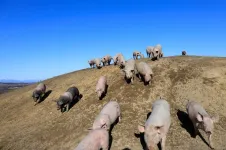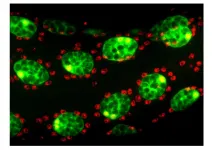INFORMATION:
Small cell lung cancer: Scientists identify two new approaches for therapy
2021-04-06
(Press-News.org) Using samples of small cell lung tumours, a research team led by biologist Dr Silvia von Karstedt has discovered two new ways to induce tumour cell death. One of two subsets of tumour cells can be targeted by activating ferroptosis: iron-dependent cell death caused by oxidative stress. In the second subtype, oxidative stress - and hence cell death - can also be induced in a different way. Both types of cell death must be triggered simultaneously by drugs to kill the majority of the tumour mass. The results of the study have been published in Nature Communications.
Despite many advances in treatment, a diagnosis of small cell lung cancer means a particularly poor prognosis. In Germany, up to 8000 new cases of small cell lung cancer (SCLC) are diagnosed each year. At the time of diagnosis, cancer has already found many loopholes to escape the body's immune system. 'Traditional' cell death mechanisms, such as regulated cell death by apoptosis, are usually already inactivated at this stage. That way, tumour cells can continue to divide and spread almost unperturbed.
A high cell division rate is characteristic of small cell lung cancer, which initially promises a good response to chemotherapy. 'Unfortunately, in many cases the success of chemotherapy is short-lived because tumour cells rapidly develop resistance to therapy. In addition, a tumour consists not only of one, but of several cell types - the so-called subtypes - each of which uses unique strategies to escape lethal therapy,' said von Karstedt, research group leader at the CECAD Cluster of Excellence for Aging Research, the Department of Translational Genomics at the University of Cologne and the Center for Molecular Medicine Cologne (CMMC). This is where her research comes in. The biologist explores which cell death mechanisms are already inactivated in cancer cells and which ones can still be targeted by therapies to kill the tumour.
The research team used patient samples taken at the time of diagnosis, thus depicting the treatment-naïve tumour. To find out which pathways of cell death are still available, the scientists compared gene activity between patient cells taken inside and outside the tumour. Signalling pathways important for traditional cell death mechanisms were already switched off inside the tumour at this early stage, before therapy. In contrast, genes important for the activation of iron-dependent cell death by oxidative damage (ferroptosis) were strongly activated in the cancer cells.
Put in simple terms, small cell lung cancer cells can be divided into two subtypes: neuroendocrine cells and non-neuroendocrine cells. In the neuroendocrine cell subtype, more genes are active which are otherwise typically found in nerve cells that produce hormones. Cells belonging to the other subtype do not have this property and are therefore grouped as non-neuroendocrine cells. 'Several experiments showed that cells of the non-neuroendocrine type can be killed using buthionine sulfoximine, which induces ferroptosis. In cells belonging to the neuroendocrine subtype, we found that they protect themselves from oxidative stress - and thus cell death - by producing antioxidants. However, by adding the antioxidant inhibitor Auranofin, we were able to kill these cells as well,' explains doctoral researcher Christina Bebber, the lead author of the paper.
Regarding a possible application of these findings to the therapy of small cell lung cancer, the biologists made an important observation: When targeting just one of the two pathways - i.e., either activating ferroptosis or inhibiting antioxidant production - in a tumour consisting of cells of both subtypes, cancer cells were able to evade the lethal therapy. They did so by adjusting their gene expression to switch to the subtype that could resist the respective single pathway-targeting treatment. 'When we applied a combination therapy, we took away this route of escape. What is also special about the study is that we used drugs that have already been tested in extensive clinical trials or even approved for the treatment of other diseases,' von Karstedt explained. Buthionine sulfoximine, which triggers ferroptosis, is already in clinical trials for cancer treatment. The gold salt Auranofin, which blocks the production of protective antioxidants in cancer cells, has been in use for decades to treat rheumatoid arthritis.
Future clinical studies using this combined therapy will clarify to what extent this targeted therapy option will improve the prognosis of small cell lung cancer patients.
ELSE PRESS RELEASES FROM THIS DATE:
Being top baboon costs males their longevity
2021-04-06
DURHAM, N.C. -- Some guys have it all: the muscle, the power, the high social status, the accelerated aging.
But wait. Faster aging? Who wants that? For male baboons, it's the price they pay to be at the top.
New research appearing April 6 in eLife by Jenny Tung, associate professor of evolutionary anthropology and biology at Duke University, and her colleagues shows that male baboons that climb the social ladder age faster than males with lower social standing. If a male drops in social status, his estimated rate of aging drops as well.
Using blood samples from 245 wild baboons in the ...
Moffitt researchers demonstrate tissue architecture regulates tumor evolution
2021-04-06
TAMPA, Fla. -- Tumors are genetically diverse with different mutations arising at different times throughout growth and development. Many models have tried to explain how genetic heterogeneity arises and what impact these alterations have on tumor growth. In a new article published in Nature Communications, Moffitt Cancer Center researchers show how the location of the tumor and spatial constraints put on it by the surrounding tissue architecture impact genetic heterogeneity of tumors.
Genetic differences are apparent among tumors from different patients, as well as within different regions of the same tumor of an individual patient. Some of these mutations may benefit the tumor and become selected for, such as mutations that allow the tumor to grow faster and spread to other ...
Hubble spots double quasars in merging galaxies
2021-04-06
NASA's Hubble Space Telescope is "seeing double." Peering back 10 billion years into the universe's past, Hubble astronomers found a pair of quasars that are so close to each other they look like a single object in ground-based telescopic photos, but not in Hubble's crisp view.
The researchers believe the quasars are very close to each other because they reside in the cores of two merging galaxies. The team went on to win the "daily double" by finding yet another quasar pair in another colliding galaxy duo.
A quasar is a brilliant beacon of intense light from the center of a distant galaxy that can outshine the ...
Breast cancer survivors' fear of cancer returning linked to genomic testing, psychological factors
2021-04-06
Breast cancer survivors with a higher risk of cancer recurrence based on genomic testing may experience greater fear of their cancer returning, according to a new study led by researchers at NYU Rory Meyers College of Nursing. However, psychological factors such as anxiety are the best predictors of survivors' fear of their cancer recurring.
"Although genomic test results were associated with fear of cancer recurrence, our findings highlight that distressing, but treatable, psychological factors fuel cancer survivors' fear of recurrence," said Maurade Gormley, PhD, RN, an assistant professor and faculty fellow at NYU Meyers and the lead author of the study, which was published in the journal Psycho-Oncology.
For breast cancer survivors, fear and worry that ...
Competing for high status speeds up aging in male baboons
2021-04-06
Battling other male baboons to achieve high social status comes with physiological costs that accelerate aging, according to study published today in eLife.
The findings suggest that current life circumstances may be more important contributors to premature aging than early life hardship, at least in baboons.
Chemical changes to DNA, also called epigenetic changes, can be used as a kind of 'clock' to measure aging. While these epigenetic changes usually correspond with age, they can also be used to detect signs of premature aging.
"Environmental stressors can make the clock tick faster, so that some individuals appear biologically older than their actual age and ...
Digital breast tomosynthesis reduces rate of interval cancers
2021-04-06
OAK BROOK, Ill. - Screening with digital breast tomosynthesis (DBT) reduces the rate of interval breast cancers compared to screening with digital mammography, according to a study published in Radiology. The study adds to a growing body of evidence supporting DBT as a breast cancer screening tool with important advantages over mammography.
DBT works by capturing a series of X-ray images of the breast from different angles. Previous research has shown that it has a higher sensitivity for breast cancer detection than digital mammography.
The impact of these additional DBT-detected cancers is not fully understood. ...
Chest CT illuminates mortality risk in people with COPD
2021-04-06
OAK BROOK, Ill. - Body composition information derived from routine chest CTs can provide important information on the overall health of people with chronic obstructive pulmonary disease (COPD), including their risk of all-cause mortality, according to a study published in Radiology.
COPD is a group of chronic, progressive lung diseases like emphysema and chronic bronchitis that affect about 30 million people in the United States alone. It is frequently associated with obesity and sarcopenia, a loss of muscle mass and strength. Obesity is associated with lower mortality in patients with COPD. The longer survival rates of obese patients compared to leaner counterparts, a phenomenon ...
Japanese consumers more concerned about gene-editing of livestock than of vegetables, survey shows
2021-04-06
A statistically rigorous survey of Japanese consumers has found that they have more negative opinions about the use of new gene-editing techniques on livestock than they do about use of the same technologies on vegetables.
The survey findings were reported in the journal BMC CABI Agriculture and Bioscience on March 31st, 2021.
Because humans tend to feel closer to animals than plants, and commonly express feelings regarding animal welfare but not plant welfare, the researchers, led by Naoko Kato-Nitta, a research scientist at Tokyo's Joint Support Center for Data Science Research and Institute of Statistical ...
How the fly selects its reproductive male
2021-04-06
Even a well-characterized genome, such as that of the Drosophila the so-called fruit fly, still holds surprises. A team from the University of Geneva (UNIGE), Switzerland, in collaboration with Cornell University (USA) and the University of Groningen (Netherlands), has discovered an RNA coding for a micro-peptide - a very small protein - that plays a crucial role in the competition between spermatozoa from different males with which the female mates. In addition to shedding new light on this biological mechanism, this work, to be read in the journal Proceedings of the National Academy of Sciences (PNAS), highlights the importance of small peptides, a class of proteins that ...
TPU scientists first obtain high-entropy carbide in electric arc plasma
2021-04-06
Scientists of Tomsk Polytechnic University have synthetized high-entropy carbide consisting of five various metals using a vacuum-free electric arc method. The research findings are published in the Journal of Engineering Physics and Thermophysics.
High-entropy carbides are a new class of materials simultaneously consisting of four or more various metals and carbon. Their main feature lies in the capability to endure high temperatures and energy flux densities. Combining various elements in the composition, it is possible to obtain the required mix of features ...








